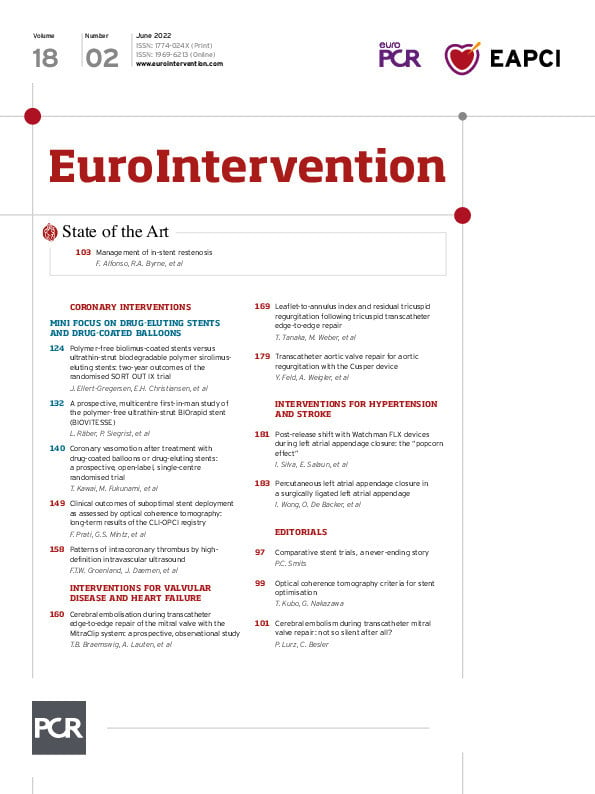In the quest for the best drug-eluting coronary stent (DES), many trials have been performed in the last 2 decades. In the beginning, differences in safety and efficacy outcomes between DES were more prominent, and superiority trials were used to show that one DES was safer and better than another. This was a success, because newer-generation DES have proven to be safer than the first-generation DES and even safer in the long-term compared to bare metal stents. Over the years, in a very competitive and lucrative DES market, industry-driven innovation has progressed rapidly. Now, we, as interventional cardiologists, have a broad range of second- or new-generation DES that we can select for our patients. But, how can we make the best choice when we have so many to choose from?
During the last ten years, comparative DES trials were mainly designed to show non-inferiority, meaning that the primary outcome with one DES is – within a certain arbitrary range – not worse when compared to another. One of the reasons for doing non-inferiority trials is that potential differences in outcomes between current DES have become small, and the sample sizes needed to show superiority of one DES over the other so large. Thus, comparative DES trials are almost impossible to conduct or fund, unless there is a research structure in place that can easily and efficiently investigate the performance and outcomes of DES with a large sample size within a relatively short period of time. The SORT-OUT program was set up by three West Danish hospitals using the national hospital database and the national registry of death together with the unique national patient identifier number (used within the Danish version of the GDPR law). This is one of the few examples of this type of research structure that has been very successful. To date, the SORT-OUT group has impressively organised 11 randomised DES trials. Initially, the group selected the DES that showed the best results in the previous trial as the comparator for the next trial. In this way, the SORT-OUT programme was able to choose the DES that would become the DES of choice. However, with the current non-inferiority designed trials showing non-inferiority between the investigated DES, the concept of selecting the best DES for the next trial was abandoned and now SORT-OUT is focusing on evaluating new concepts, like polymer-free DES or dual-coated DES. On top of this, the SORT-OUT programme is helpful to device companies in evaluating their products in a general population.
In order to evaluate the performance and outcomes of DES, several components of DES are important: (i) the type and concentration of the antiproliferative drug; (ii) the release kinetics of the drug; (iii) the type of polymer coating - if present - from which the antiproliferative drug is released; (iv) the connecting layer between the polymer and the metal surface; and (v) the metal platform itself (type of metal alloy, strut thickness and stent configuration). It’s impossible to evaluate the impact of the differences of each component in separate trials as no DES exists where only one component is different from the components of all other DES. Therefore, current comparative DES trials have their limitations, and only general conclusions can be drawn on the tested DES concepts. The same applies for the current paper by Julia Ellert-Gregersen et al in this issue of EuroIntervention1. Julia Ellert-Gregersen et al report the two-year outcomes of the SORT-OUT IX trial, in which the polymer-free biolimus-eluting stent (BioFreedom; Biosensors) is compared to the biodegradable polymer-coated sirolimus-eluting stent (Orsiro; Biotronik). Apart from differences in the polymer coating and drug release concepts, the BioFreedom (without polymer) and the Orsiro (with 2 different biodegradable polymer layers which degrade in 24 months) stents also differ in the type of antiproliferative drug (biolimus vs sirolimus), stent strut thickness (120 vs 60-80 micron, depending on the Orsiro stent size) and metal alloy (stainless steel vs cobalt-chromium). In an all-comers population (n=1,572 patients), both stents were compared, showing non-inferiority of the BioFreedom stent compared to the Orsiro stent in the composite endpoint of target lesion failure (TLF) at 1 and 2 years, but showing a significantly higher target lesion revascularisation (TLR) rate at 1 year which remained present at 2 years, though not in the landmark analysis after 1 year12.
Although the difference in the TLR rate does not come as a surprise to me, the question is more, what has caused this difference? The release kinetics of the limus analogues differ significantly between both DES. Biolimus, with a 10-fold higher lipophilic drug compared to sirolimus3, is released from the BioFreedom stent within a few days with a peak at 2 hours4, whereas sirolimus is gradually released within 3 months from the polymer of the Orsiro stent. Also, the difference in strut thickness could have contributed to the higher TLR rate with the BioFreedom stent. In a recent meta-analysis, ultrathin (60 micron) struts (present in Orsiro stents of 3.0 mm and smaller) show consistently lower TLR rates compared to non-ultrathin second-generation DES5.
More relevant is the fact that the BioFreedom stent was developed for patients at high bleeding risk needing a short duration of dual antiplatelet therapy (DAPT). So, to compare this concept in an all-comers population with standard duration DAPT is perhaps not fair.
In any case, the development of DES is evolving at a rapid pace, and a newer-generation BioFreedom thin-strut cobalt-chromium stent is now on the market. Whether this will make a difference, compared to Orsiro, in a population treated with a short duration of DAPT needs to be determined. Perhaps SORT-OUT XII is born?
Conflict of interest statement
In the last three years, P. Smits has received institutional research grants from Abbott Vascular, Microport, SMT and Daiichi Sankyo; and has received speakers/consultancy fees from Abbott Vascular, Microport, Terumo, AstraZeneca and Abiomed.
Supplementary data
To read the full content of this article, please download the PDF.

